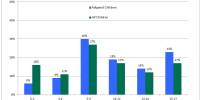Lending facilities restrictions
The bank establishes a specific industry sector exposure cap by preparing a sector wise loan budget in order to avoid over concentration in any one-industry sector. The
budget is approved by the Board in the month of January every year and includes the following points:
- Total Facilities: The aggregated of all cash facilities is kept at 80% of customer’s deposits. It is also governed by the statutory and liquidity reserve requirement of Bangladesh Bank.
- Term Facilities: Aggregated long-term facilities are restricted to 20% of the total loan portfolio and are not allowed for a period more than 5 (five) year.
- Unsecured Facilities: Aggregate bank loans to corporate or individual customers who are not secured by collateral and are allowed on the strength of customer’s personal integrity and financial standing or the corporate customer’s balance sheet, with or without hypothecation of stock is restricted to 30% of the total loan portfolio.
- Sector-wise Allocation: Sector-wise allocation of loan budget is made in the month of January of each year with the approval of Executive Committee/Board of Directors. This is reviewed from time to time.
- Security: Security accepted against loan facilities is properly valued and is affected in accordance with the laws of the country in which the security is held. An appropriate margin of security is taken to reflect such factors as the disposal cost or potential price movement of the underlying assets.
Investment facilities not provided for Business Types
The Bank does not provide loan facilities to the following businesses:
¯ Military Equipment/Weapon Finance.
¯ Highly Leveraged Transactions.
¯ Finance of Speculative Loans.
¯ Logging, Mineral Extraction/Mining, or other activity that is ethically of Environmental sensitive.
¯ Lending to companies listed on CIB black list or known defaulters.
¯ Counter parties in countries subject to UN sanctions.
¯ Share lending.
¯ Taking an equity stake in Borrowers.
¯ Lending to Holding Companies.
¯ Bridge Loans relying on equity/debt issuance as a source of repayment.
¯ Tannery Finance.
¯ Izara Bill Baia (HB-residential) who has no other business with the Bank.
GENERAL LENDING PRINCIPLES OF EXIM BANK
Lending of funds to the traders, businesses and industrial enterprises constitutes the main business of the bank. A major part of the bank’s income is earned from interest and discount on the funds so lent. The business of lending, nevertheless, is not without certain inherent risks. Largely depending on the borrowed funds, a banker cannot afford to take
Undue risks in lending. While lending its fund, the bank, therefore, follows a very cautious policy and conducts its business on the basis of the well-known principles of sound lending in order to minimize the risks. The bank usually follows the following lending principles in its credit management operations:
- Safety: As the bank lends the funds entrusted to it by the depositors, the first and foremost principle of lending is to ensure the safety of the funds lent. By safety it is meant that the borrower is in position to repay the loan, along with interest, according to the terms of the loan contract. The bank takes utmost care in ensuring that the enterprise or business for which a loan is sought is a sound one and the borrower is capable of carrying it out successfully and is a person of integrity, good character and reputation.
- Purpose: The bank does not grant loan for each and every purpose. Bank has its own policy regarding the purpose for which it provides loans. Loans are normally provided for productive purposes only such as working capital, trading, agricultural, transport, export-import etc. The bank does not grant loans for purely speculative purposes, unproductive purpose such as social functions or holiday or for repayment of prior loans and business having negative net-worth if it is not covered by cash/quasi cash securities with adequate margin.
- Profitability: Since the bank is a profit-earning institution, it employs its funds profitability so as to earn sufficient income out of which to pay interest to the depositors, salaries to staff and to meet various other establishment expenses and distribute dividend to shareholders. The bank usually considers high yielding, short-term, and self-liquidating with ancillary business/compensating deposits and prefers quality advances. The bank keeps a spread of lending rate over its expenses that include deposit interest payment and other operating and overhead expenses. The bank is free to determine its interest rates.
- Liquidity: Bank lends funds for short periods. The loans are, therefore, largely payable on demand. The bank ensures that the borrower is able to repay the loan on demand or within a short period. The bank grants loans on the security of assets, which are easily marketable without much loss.
- Dispersal/Diversification: The bank keeps its investment portfolio as much broad based as possible and in conformity with the deposit structure. The bank does not provide investments in one
Particular direction/industry/activity or one or few borrowers because any adversity faced by that particular industry will have serious adverse affect on the bank. Again, investment s are not concentrated in one area alone. The bank spreads its loans against different securities, industries/activities, borrowers, areas, etc. This way the bank diversifies its risks.
- National interest/social benefit: The Bank grants loan if the purpose of the investment is for overall plans necessitating flow of credit to priority sector in the larger national interest. National interest for financing in some areas, especially in advances to agriculture, small industries, export oriented industries, and assuming great importance. The bank also looks at the social and environmental implication of the project or business that it is financing.
BORROWER/GROUP LIMITS/SYNDICATION:
Bank may allow investment facilities to a single customer/Group (Funded & non funded) up to its 50% of total capital out of which funded facilities must not exceed 25% of total capital. All proposal submitted to Head Office will also be required to indicate the extent of the Bank’s global exposure to that customer group.
Group exposure shall be deemed to include the total investment facilities as detailed below:
- Investment facility in the name of the borrower.
- Investment facility in the name of the firms & companies in which the borrower or its partner or its director is the proprietor or a partner or a Director.
- Investment facility in the name of any firm of company in which the borrower or its partner or its director owns 20% or more share even if not a Director.
- Any Investment facility guaranteed by the borrower or its partner, or its Director.
However, definition of group exposure if given by Bangladesh Bank shall be followed regardless of the above definition.
Investments favoring various client groups:
Table-3
| Amount in Taka | ||
| Particulars | 2009 | 2008 |
| Abul Khair Group Nitol Group S. Alam Group Shamsul Alamin Group Shah Sharif Group Imam Group KDS Group Nurul Alam Master Group PHP Group SMAH Group Amtranet Group Wills Group AKH Group | 144,600,000 329,935,514 255,096,529 204,363,000 153,988,000 172,100,000 133,900,000 116,943,919 409.115,341 102,434,000 14,731,000 62,709,698 252,454,000 2,352,371,001 | 262,700,000 293,125,462 356,244,999 326,128,000 152,586,000 145,228,000 126,385,000 63,793,054 131,711,443 103,145,000 25,576,219 68,515,163 62,720,873 2,117,859,213 |
INVESTMENT INVESTIGATION
Lending is one of the most important functions of a bank. Therefore, It is of paramount importance that the bank chooses a reliable borrower. For this the bank places the kind of mechanism(s) that helps it identify the borrower who can be creditworthy. This section deals with some of the mechanisms that the bank employs for this end.
- Investment Application form: A investment application form usually contains information pertaining to the name of the concern, constitution, nature and place of business, year of establishment, borrower’s experience in the line, particulars of assets and liabilities, purpose of advance, amount required, period of advance required for, nature of security offered, sources of repayment, names of present bankers with detailed borrowing and other facilities. This is the first step of knowing about the borrower.
- Personal Interview: The bank arranges interview with the borrower to know more about his specific requirements, the prospects of his employing the funds prudently, his capacity to repay and the suitability of the security offered. The main points that are covered in the interview are: his business, all legal documents required for operation of his business (Memorandum and Article of Association, trade and import license), his capital with reference to working capital, his experience in the business, results of financial statements of at least three years, amount of investment and period, purpose of advance, source of repayment, terms of payment, security documents that are offered, types of charge available. The bank officials who conduct the interview try to analyze and judge for themselves the correctness or otherwise of the various statements and documents of the prospective borrower and to arrive at a balanced opinion regarding the acceptability or otherwise of the proposal.
If, after the initial interview, the commercial credit officer decides that the loan request meets basic bank lending criteria, the next step is to conduct a more in-depth investigation, relying upon the documents obtained from the client and from bank’s own and outside sources.
Investment Recovery
The bank has a Recovery Unit (RU) under CRM. It directly manages account with sustained deterioration (a Risk Rating of Sub Standard (6) or worse).
The RU’s primary function is:
- Determine Account Action Plan/Recovery Strategy.
- Pursue all options to maximize recovery.
- Ensure adequate and timely investment loss provisions are made based on actual and expected losses.
- Regular review of grade 6 or worse account
Capital and Reserve Fund
The authorized and Paid up Capital of the Bank “‘(as Tk.1000 million and Tk225.00 million while it started its Banking operation in 1999. The Capital and reserve of the Bank as on 31st December 2009 stood at Tk.1400.00 million. The Bank also made a 1% general provision on unclassified investments of the Bank, which amounted to Tk.188.22 Million.

















